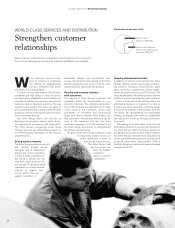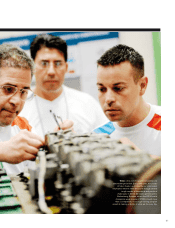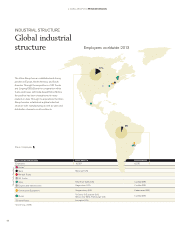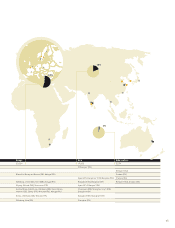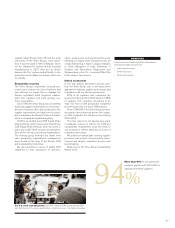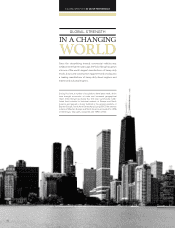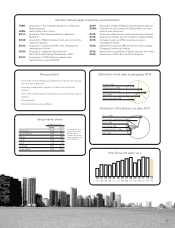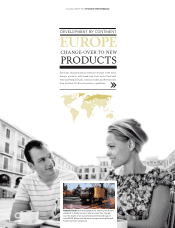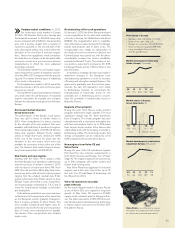Volvo 2013 Annual Report Download - page 47
Download and view the complete annual report
Please find page 47 of the 2013 Volvo annual report below. You can navigate through the pages in the report by either clicking on the pages listed below, or by using the keyword search tool below to find specific information within the annual report.
Europe 55%
North America 17%
South America 6%
Asia 19%
Other countries 3%
Geographic distribution of employees
The Volvo Group views its corporate culture as a
unique asset, since it is diffi cult for competitors to
copy. By applying and strengthening the expertise
and culture we have built up over the years, we can
achieve our vision.
The Volvo Way shows what we stand for and aspire
to be in the future. It lays the foundation for develop-
ing the Volvo Group into the world’s leading provider
of commercial transport solutions. It is a recipe for
success in which we strongly believe. It expresses the
culture, behaviors and values shared across the Volvo
Group.
The Volvo Way is based on the conviction that
every individual has the capability and the determina-
tion to improve our business operations, and the
desire to develop professionally.
The Volvo Way is the lively dialogue between lead-
ers, within teams, and among colleagues around the
world. This is the way we conduct business and
deliver results. This is how we partner with customers
and suppliers, how we work and change, and how we
build the future together.
The Volvo Group’s position on human rights is
refl ected in the Code of Conduct. It includes:
• Non-discrimination
• Non-tolerance of forced labor
• Non-tolerance of compulsory or child labor
• Freedom of association
• The right to collective bargaining
• The right of all employees to a healthy and safe
work environment
• Working hours and compensation.
HUMAN RIGHTS IN OPERATIONS
Vocational training
schools in Africa
In partnership with Sida and USAID, the
Volvo Group will introduce vocational
training schools for mechanics and vehi-
cle operators in ten African countries.
The aim is both to create a market for the
Group’s products and to promote growth
in these countries.
– By the training schools we are con-
tributing to local fi nancial development as
our business grows. This is a win-win sit-
uation, made possible by a public-private
partnership, says Volvo’s President and
CEO Olof Persson.
Ten countries
In partnership with the Swedish Interna-
tional Development Cooperation Agency
(Sida) and the equivalent United States
Agency for International Development
(USAID), the Volvo Group will introduce
vocational training schools in ten African
countries over a period of fi ve years,
commencing in 2014. In consultation with
local authorities, the Volvo Group, Sida
and USAID will design and fi nance voca-
tional trainings in which students can be -
come mechanics, and learn to operate
ve hicles, trucks, buses and construction
equipment.
– The generation of decent jobs gives
people the ability to support themselves
in the long term. By working in public-pri-
vate partnerships we can generate more
resources for sustainable development
and contribute together in actions against
poverty, says Charlotte Petri Gornitzka,
Sida’s Director-General.
By contributing expertise, manuals,
products and exchanges, the Volvo
Group is helping to build up a pool of
mechanics that is required for future sales
of its products in these countries. The
Group’s contribution to the vocational
trainings amounts to SEK 30 M.
Sustainable business
The schools will be the continuation of a
pilot project that the Volvo Group con-
ducted through Volvo Construction
Equipment in partnership with Sida in
Addis Ababa, Ethiopia, where a voca-
tional school received extra resources to
train mechanics for construction equip-
ment. Due to Volvo CE’s participation in
the project, the students have gained
access to modern machinery.
The training schools will be set up in
countries that are both business-critical for
the Volvo Group and eligible for develop-
ment grants from both Sida and USAID.
– A sustainable development within
social, fi nancial, and environmental
dimensions is something that we see as
a necessary prerequisite for long-term
profi tability. By training local labor to sell,
drive and serve our products we are
broadening our own market and at the
same time contributing to sustainable
growth in the countries in which the
Volvo Group is active, says Olof Persson.
THE VOLVO WAY
43







